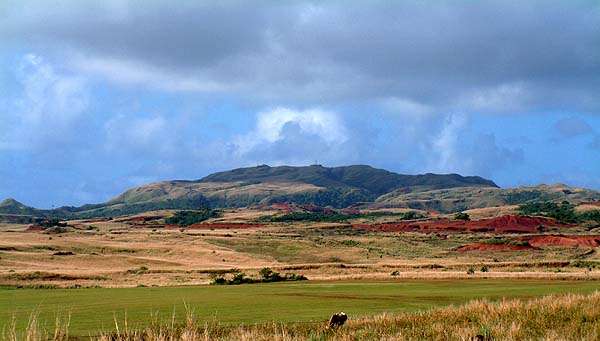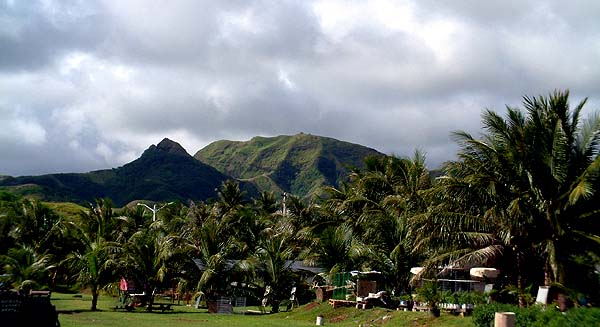 |
 |
 |
 |
||||
|
|
|
|
|
|
|
|
|
|
|
|||||||
|
|
|
|
Mount Sasalåguan.
|
|
|
“There’s an account of a supernatural spirit named Chaife" Anne relates. "Chaife was a blacksmith. One day he lost control of some of the fire and that’s how spirits came into being, and the spirits who escaped Chaife’s fires, some of them entered the souls of the people and other ones went into land. That’s how this kind of spirit--everything having a spirit--was created. “Now a couple of interesting things come out of this story. First, it raises the question, did the Chamorros have knowledge of iron before Magellan? When Magellan came, maybe they knew what they were looking for, from connections between Guam and Asia. Maybe they just didn’t have a lot of it, but they knew of it. And if they have a god who’s a blacksmith, then they have knowledge of it. Also, the Chamorro word for iron, lulok, is not derived from the Spanish word, suggesting again that they had knowledge of it before the Spanish arrived.
|
||
|
|
||
|
|
|
"Second, it shows you the impact of Christianity. In Chamorro mythology, Chaife worked on Mount Sasalåguan. Sasalåguan today means ‘hell.’ The Spanish define it as ‘hell’ because it relates to spirits. Also because of the forge and fire. "Sasalåguan is a source of spirits. These spirits were called ante. And in Chamorro thinking, everything has spirit. So there’s aniti in the rocks, and ante in the trees. To me it really didn’t have a negative value, that the word didn’t have a moral value. Kind of like what Polynesians call ‘mana.’ But if you look up ante in the Chamorro dictionary it means “devil.” About the biggest insult you can call a Chamorro is ‘manganiti': 'You’re the devil.’ And it’s from that word ‘ante’ which in the ancient Chamorro vocabulary did not mean ‘evil,’ just meant ‘the spirit.’ But it wasn’t the Holy Spirit or the Christian spirit.
|
||
|
|
||
|
Below and behind Mount Sasalåguan from Inarajan are two other Southern villages that are important neighbors for Inarajan.
|
||
|
|
||
|
|
|
|
|
|

|
| Inarajan Home | Map Library | Site Map | Pacific Worlds Home |
|
|
|
|
|
|
|
|||
| Copyright 2003 Pacific Worlds & Associates • Usage Policy • Webmaster |
|||




